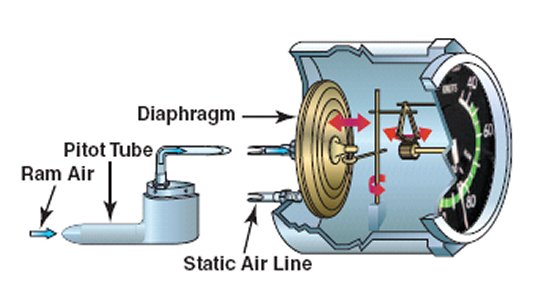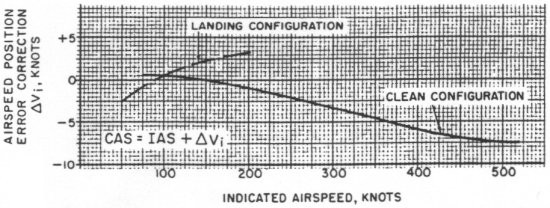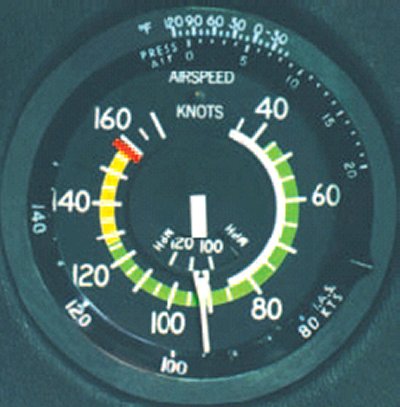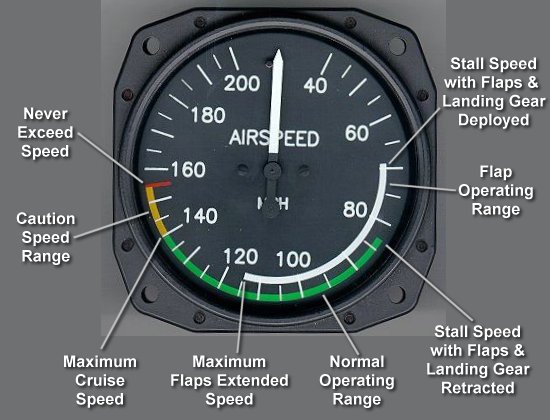|
||||||||||
|
|
||||||||||
|
||||||||||
|
|
||||||||||

A key device you will see on the nose or wing of most aircraft is called a pitot tube. The purpose of this instrument is to measure the dynamic pressure, sometimes called the ram or impact pressure, the plane experiences as it moves through the air. Aircraft also take another measurement of the atmospheric pressure that is called the static pressure. The difference between the dynamic and static pressures is used to determine the indicated airspeed (IAS) that is displayed to the pilot on the airspeed indicator in the cockpit. This display is usually shown in KIAS which stands for Knots Indicated Air Speed.

However, the indicated airspeed is not always completely accurate. Errors are often introduced by the design of the measuring instruments, lag in the time it takes for the system to update, or the location of the pressure probes on the aircraft. Although these errors are typically small, they can introduce discrepancies as large as several knots. The most significant source of instrumentation error is that due to the position of the pitot-static probes. This type of error tends to vary primarily with speed and angle of attack since it is difficult to find a location on an aircraft that will always measure static pressure correctly at all combinations of these variables. The position error is usually greatest at low speeds and high angles of attack, like those encountered during takeoff and landing, but smallest during cruise flight.

To correct for these errors, manufacturers provide an airspeed calibration chart for each aircraft. This chart allows a pilot to correct for the discrepancies and calculate the calibrated airspeed (CAS). Calibrated airspeed is defined as the indicated airspeed corrected for instrumentation errors in the pitot-static pressure measurement system. Many modern aircraft correct for these errors internally and automatically display the CAS, instead of IAS, on the airspeed indicator gauge as in the example pictured below. Regardless, the instrumentation errors are typically small such that IAS and CAS are very close.

Another source of error in airspeed measurement is independent of the measuring instruments but due to an aerodynamic effect called compressibility. When flying faster than about 200 knots, the air being rammed into the pitot tube becomes compressed or squeezed to a higher pressure than it would if the fluid were an ideal incompressible substance. This compressibility error increases the faster the aircraft flies and grows particularly large near Mach 1. It is because of this effect that many World War II pilots like Hans Mutke believed they had flown faster than the speed of sound even though their planes were not actually capable of doing so.
Like instrumentation error, the compressibility error can also be accounted for using an airspeed correction chart. The result of this correction is the equivalent airspeed (EAS). The faster and higher an aircraft flies, the larger the correction becomes and the greater the difference between CAS and EAS. Equivalent airspeed is defined as the speed at sea level that would produce the same dynamic pressure as the true airspeed at the altitude the vehicle is flying at. For example, if a plane is flying at 500 KTAS (Knots True Air Speed) at 20,000 ft, the true dynamic pressure is 451 lb/ft² and the equivalent airspeed is 365 KEAS (Knots Equivalent Air Speed). Conversely, a true airspeed of 365 KTAS at an altitude of 0 ft results in a dynamic pressure of 451 lb/ft².

The final source of error that must be accounted for is the decrease in air density that a plane experiences the higher it flies. At very high altitudes, the density eventually drops to near zero. A vehicle in orbit, for example, typically travels at a speed of about 17,000 mph (27,355 km/h). At this extreme altitude, however, there is very little air to ram into a pitot tube so the indicated, calibrated, and equivalent airspeeds will be virtually zero.
This density error can be corrected for if the pilot knows the atmospheric density at the plane's current altitude. This piece of information is typically calculated using the static pressure provided by the pitot-static system and the atmospheric temperature. Once density is known, the equivalent airspeed can be converted to true airspeed (TAS). Another approach to estimate the true airspeed is a rule of thumb technique based on the indicated airspeed and altitude. In this approach, the pilot simply increases the IAS by two percent for every thousand feet of altitude to approximate the TAS. Many airspeed indicators also include a sliding scale to perform this conversion for the pilot and provide the TAS. You can perform many of these airspeed conversions yourself using the Atmospheric Properties Calculator on this site.
True airspeed is the actual speed of an aircraft with respect to the air through which it flies. This speed is what determines the aerodynamic behaviors of an aircraft such as its Mach number, lift, and drag. True airspeed is also important for navigation purposes since it is related to how quickly the aircraft will reach its destination. The other critical factor that plays a role in navigation is the wind speed. The winds add to or subtract from the true airspeed to determine the ground speed, which is ultimately the speed that a pilot wants to know for navigation. Ground speed is the speed of an aircraft with respect to a fixed point on the Earth's surface.
However, there is no direct method for an aircraft to measure the speed of the winds in the air mass through which it flies. The determination of ground speed instead relies on some external source like radio beacons or the Global Positioning System (GPS). These systems allow the position of an aircraft to be determined at any point in time during its flight. By calculating the rate of change in its position, it is possible to determine the speed of the plane along the ground. The difference between airspeed and ground speed can then be used to estimate the wind speed.
The speeds a pilot typically sees in the cockpit are either the indicated or calibrated airspeeds, depending on what is displayed on the airspeed indicator gauge, and the ground speed if the aircraft is equipped with some kind of GPS receiver. While a pilot has the means to calculate equivalent and true airspeeds, these are primarily intermediate results that are not typically needed in and of themselves.

The airspeed indicator in the cockpit is also covered in color-coded markings that provide the pilot with important information to operate the plane safely. These markings denote regions where the plane can be safely operated and limits that should not be exceeded. The purpose of the markings used on a typical single-engine light plane is described below.
Read More Articles:


|
Aircraft | Design | Ask Us | Shop | Search |

|
|
| About Us | Contact Us | Copyright © 1997- | |||
|
|
|||